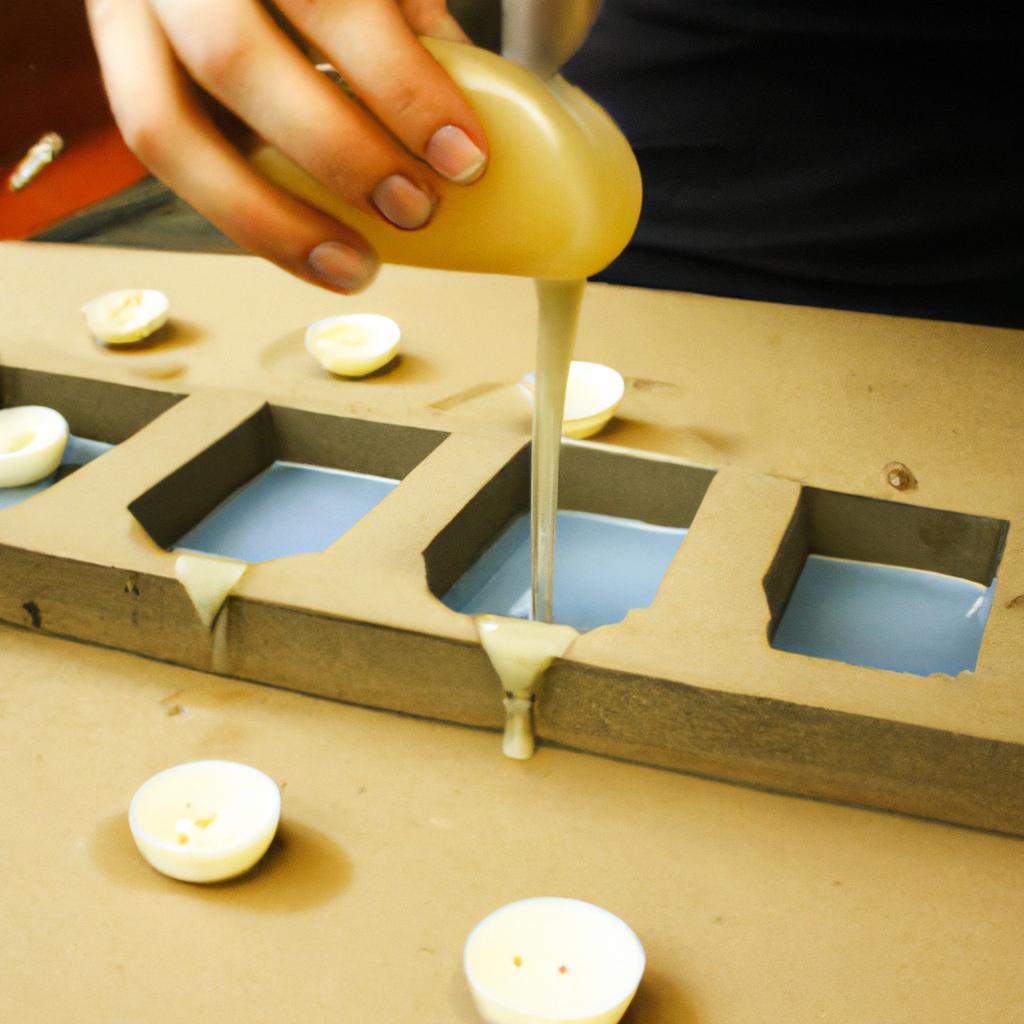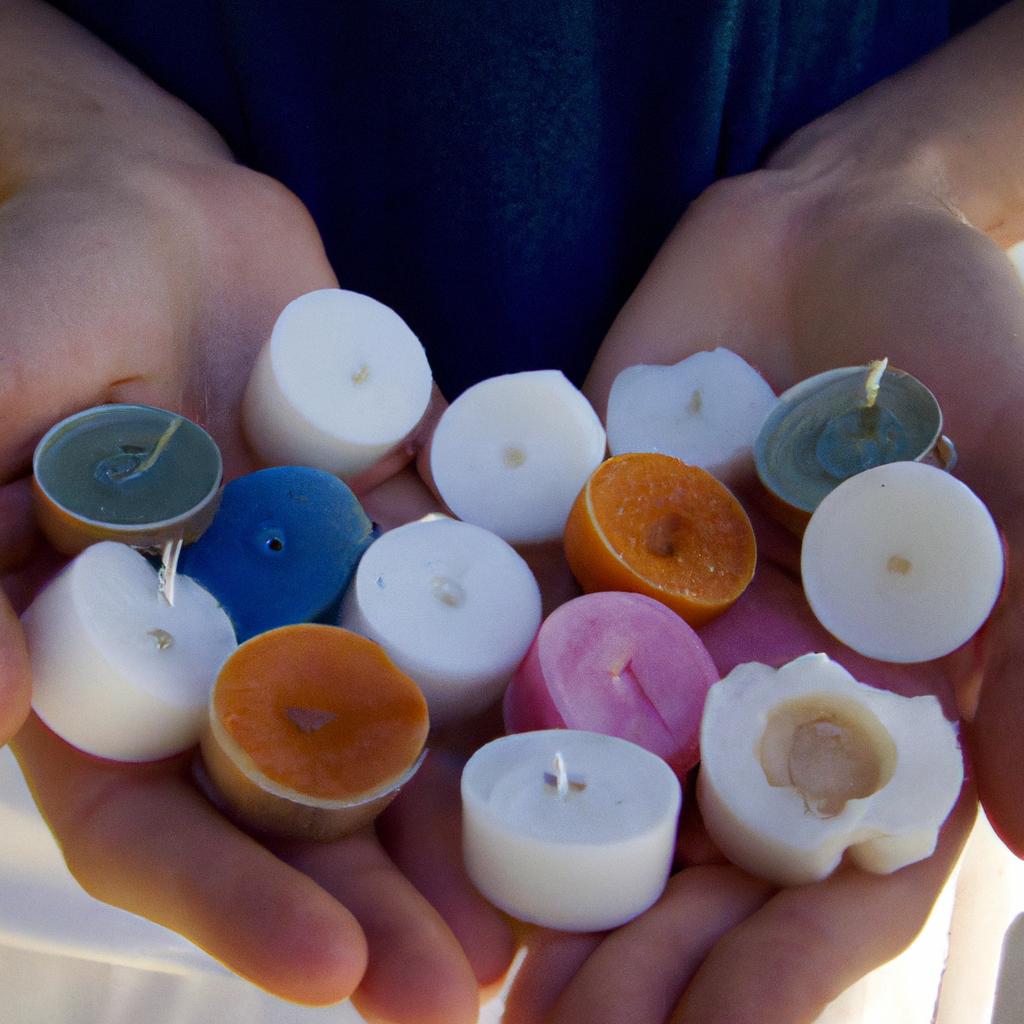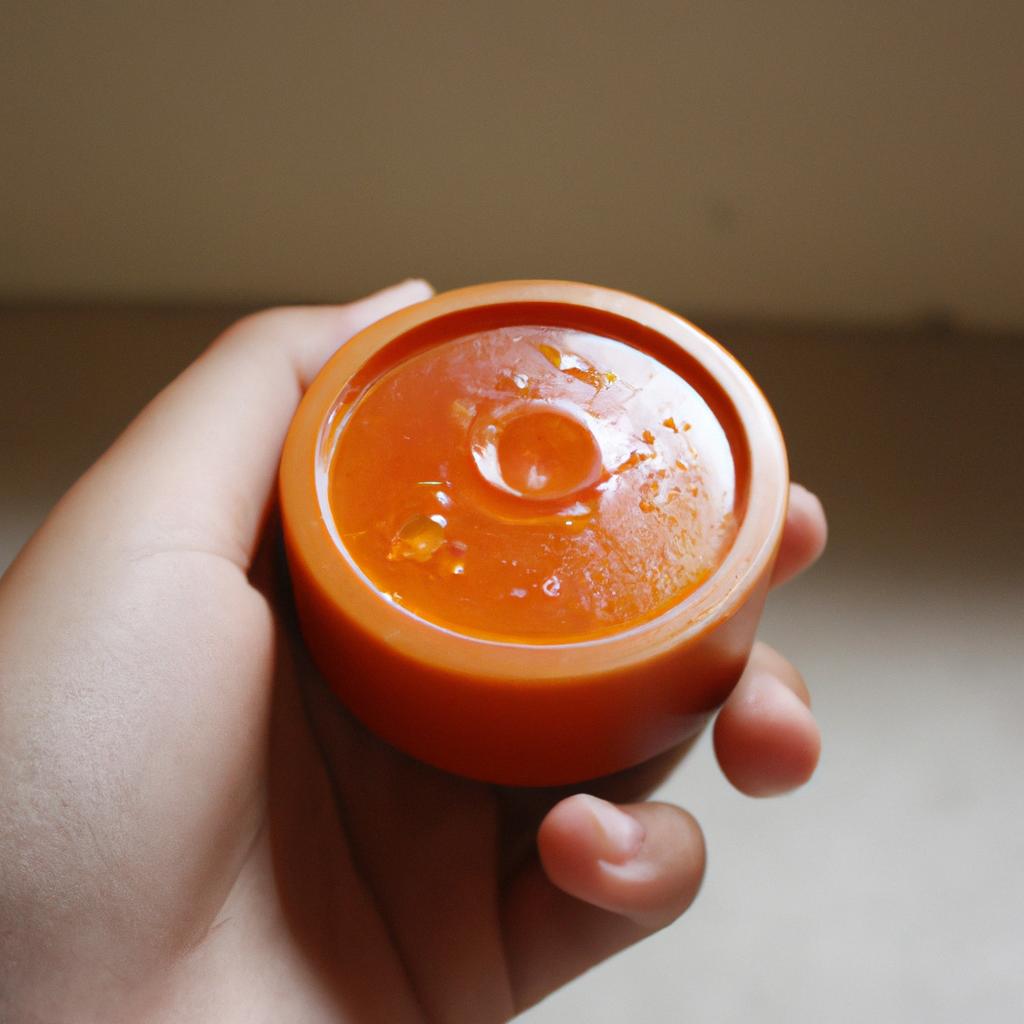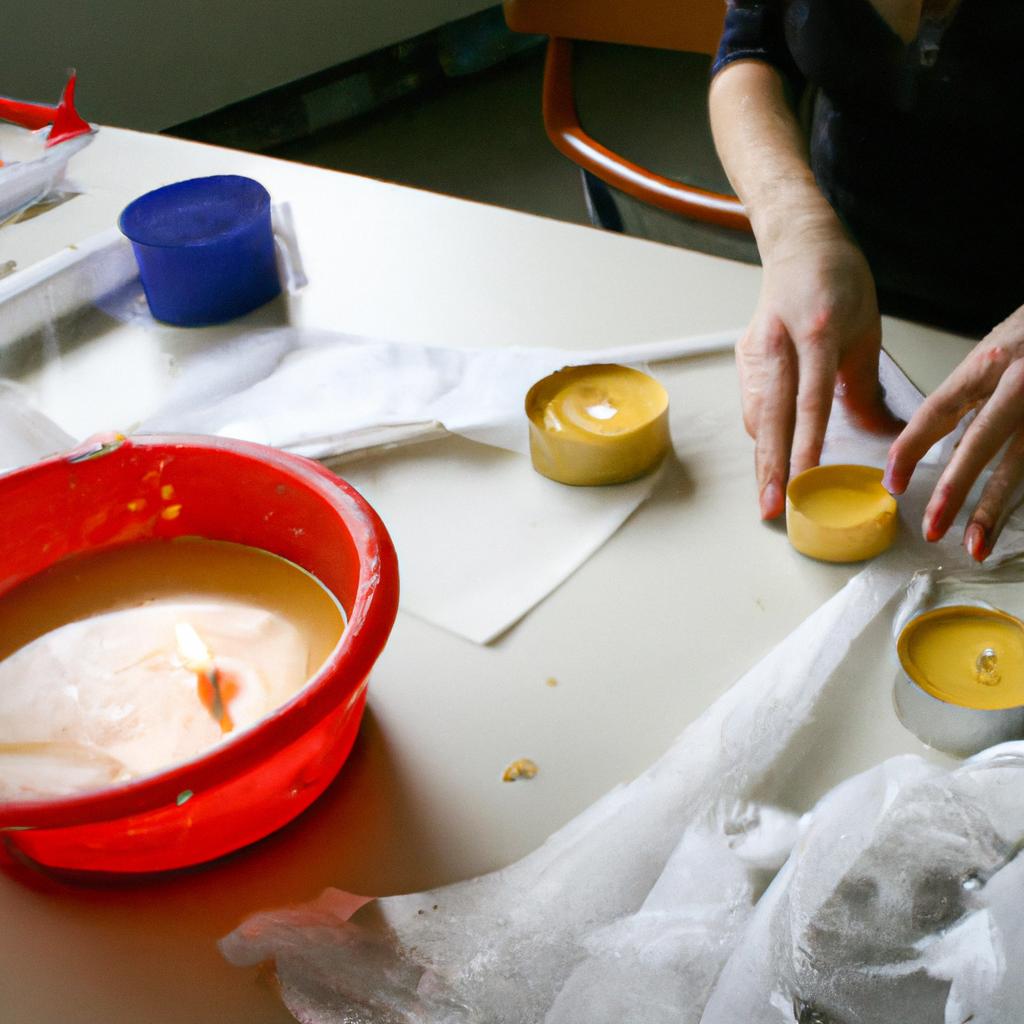Soy Wax in Candle Making: Types of Wax
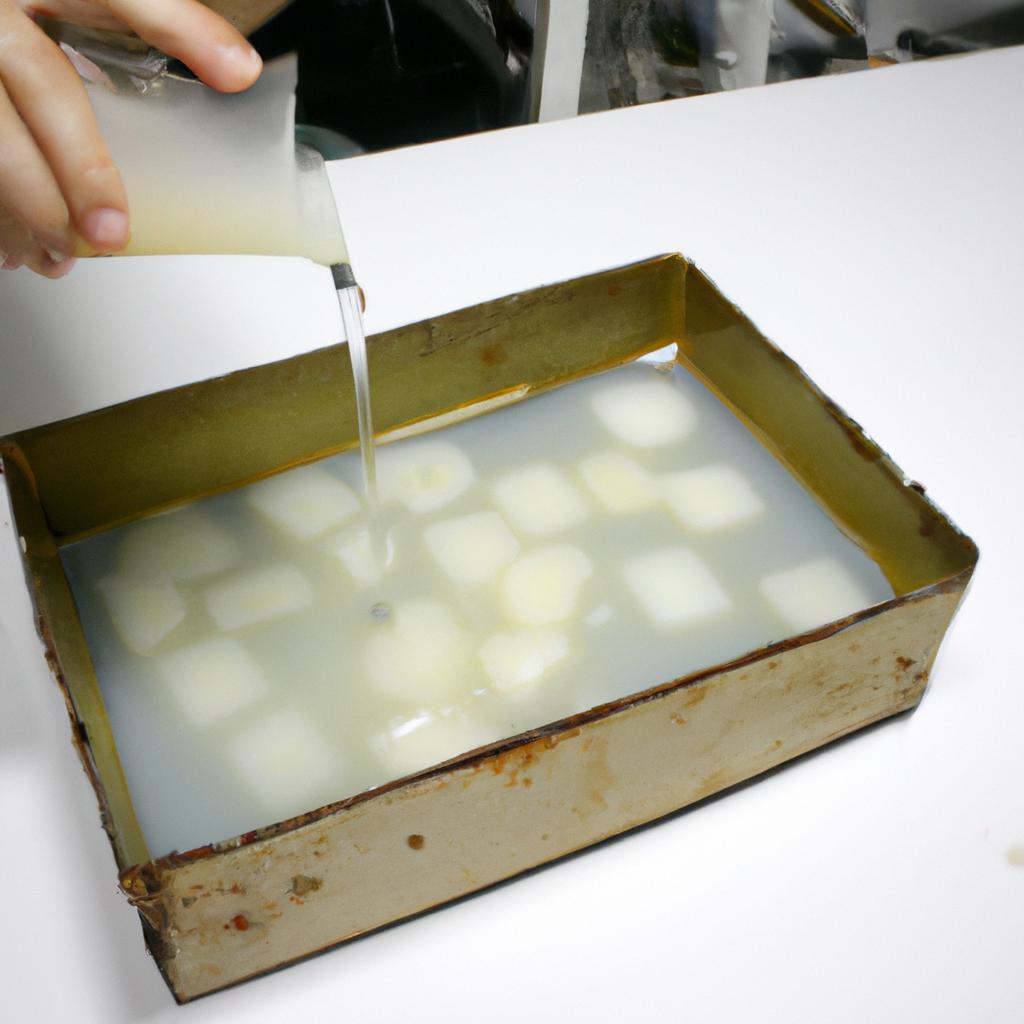
Soy wax has gained significant popularity in the candle making industry due to its numerous advantages over traditional paraffin wax. This article aims to provide an overview of the different types of soy waxes available for candle making, highlighting their characteristics and benefits. By exploring case studies and hypothetical scenarios, readers will gain a comprehensive understanding of how selecting the right type of soy wax can greatly impact the quality and performance of their homemade candles.
One such example is that of a small-scale artisanal candle maker who wants to create eco-friendly candles with clean-burning properties. In this scenario, choosing the appropriate soy wax becomes crucial in achieving these objectives. Understanding the various types of soy waxes available on the market allows them to make informed decisions based on factors such as melting point, fragrance retention, color stability, and container adhesion. Through examining real-world cases like this one and delving into theoretical possibilities, this article will explore the diverse options within soy wax production, enabling both novice and experienced candle makers alike to enhance their craft by utilizing suitable waxes tailored to their specific needs.
Understanding Soy Wax
Understanding Soy Wax
Imagine walking into a cozy room, the air filled with a delightful aroma. The warm flickering glow of candles casts a soothing ambiance, creating an atmosphere of relaxation and comfort. Have you ever wondered what kind of wax is used to create these beautiful candles? One popular choice among candle makers is soy wax.
Soy wax is derived from soybean oil, making it a natural alternative to traditional paraffin or beeswax. It has gained popularity in recent years due to its eco-friendly nature and numerous benefits for both consumers and producers. To fully appreciate the value of soy wax in candle making, it is essential to understand its characteristics and how it compares to other types of waxes.
Characteristics of Soy Wax
- Renewable: Soy wax is made from soybeans, which are a sustainable resource that can be replenished every year.
- Clean-burning: Unlike paraffin wax, soy wax burns more cleanly without emitting harmful toxins such as benzene or toluene, contributing to better indoor air quality.
- Longer-lasting: Due to its lower melting point, soy wax tends to burn slower than other waxes, resulting in longer burning times for candles.
- Excellent scent throw: Soy wax has excellent fragrance-holding capabilities, allowing candles made with this type of wax to release their scents evenly and effectively throughout the room.
To illustrate the differences between various types of waxes commonly used in candle making, consider the following comparison table:
| Wax Type | Sustainability | Indoor Air Quality | Burn Time | Scent Throw |
|---|---|---|---|---|
| Paraffin | Non-renewable | Emit toxic fumes | Short | Moderate |
| Beeswax | Natural | Minimal emissions | Long | Good |
| Soy | Renewable | Low emissions | Long | Excellent |
As shown in the table, soy wax offers a compelling combination of sustainability, clean-burning properties, longer burn times, and excellent scent throw. These characteristics make it an attractive choice for both candle enthusiasts and those concerned about environmental impact.
Moving forward to the next section on the benefits of soy wax in candle making, we will delve deeper into how these unique qualities contribute to its growing popularity among candle makers worldwide.
Benefits of Soy Wax in Candle Making
Types of Soy Wax in Candle Making
In the world of candle making, there are various types of soy wax available for crafters to choose from. Each type has its own unique characteristics and advantages, allowing candle makers to create candles that suit their specific needs and preferences. Let’s explore some of the most commonly used types of soy wax.
One example is the Golden Brands 464 Soy Wax, which is widely popular among candle makers. This particular soy wax is known for its excellent scent throw and smooth finish when poured into containers or molds. It has a low melting point, making it easy to work with during the melting and pouring process. Additionally, this type of soy wax has good adhesion to glass containers, resulting in less frosting on the surface of finished candles.
When selecting a soy wax for candle making, here are some factors to consider:
- Melting Point: Different types of soy waxes have varying melting points. Some have lower melting points, while others have higher ones. The melting point can affect how well the fragrance oils blend with the wax and how long your candles will burn.
- Fragrance Load: Certain soy waxes can hold a higher percentage of fragrance oil compared to others. Consider the intensity of scent you want your candles to have and choose a soy wax that allows for a higher fragrance load if desired.
- Appearance: Some soy waxes produce a creamy appearance when poured into containers, while others may result in a more glossy finish. Think about what aesthetic appeal you’re aiming for in your finished candles.
- Environmental Impact: Many candle makers opt for eco-friendly options such as sustainable and renewable soy waxes that do not contribute significantly to deforestation or harm natural habitats.
Now that we’ve explored different types of soy wax in candle making let’s delve deeper into understanding the grades associated with these waxes. By understanding these grades, you’ll gain further insight into choosing the right type of soy wax for your candle making projects.
Different Grades of Soy Wax
Types of Soy Wax
After exploring the numerous benefits of soy wax in candle making, it is crucial to delve into the different types of soy wax available. Understanding these variations will enable candle makers to select the most suitable option for their specific needs.
One example of a popular type of soy wax is Golden Brands 464 Soy Wax. This particular variety offers excellent fragrance retention and an even burn, resulting in high-quality candles that fill a room with delightful scents. Additionally, it has a lower melting point compared to other waxes, which facilitates easier pouring and reduces the risk of overheating during the candle-making process.
When choosing soy wax for candle making, several factors should be considered:
- Melting Point: Different types of soy waxes have varying melting points, affecting how well they perform under various conditions.
- Container Size: The size and material of the container used for candles can impact which type of soy wax is most appropriate.
- Scent Throw: Some varieties offer better scent throw than others, ensuring that fragrances are effectively dispersed when the candle is burned.
- Eco-Friendliness: It’s important to consider if the soy wax chosen aligns with eco-friendly values and practices.
To further illustrate these differences, let’s take a look at this table comparing three common types of soy wax:
| Type | Melting Point (°F) | Fragrance Retention | Suitable Containers |
|---|---|---|---|
| Golden Brands 444 | 119-125 | High | Glass or Tin |
| NatureWax C3 | 120-125 | Medium | Various |
| Ecosoya Q210 | 122 | Low | Glass or Ceramic |
As evident from this table, each type of soy wax possesses unique characteristics that appeal to different preferences and requirements. By carefully considering these distinctions alongside personal goals, candle makers can select the most appropriate soy wax for their creations.
Transitioning into the subsequent section about “Blended Soy Wax,” it is important to explore how different combinations of waxes can further enhance the benefits and qualities of soy wax.
Blended Soy Wax
Types of Soy Wax
After exploring the different grades of soy wax, let’s dive into the various types of soy wax available in the market. Understanding these distinctions can help candle makers choose the most suitable option for their specific needs.
One example that illustrates this is a case study conducted by a group of experienced candle makers. They compared three different types of soy waxes: Golden Brands 464, EcoSoya Advanced, and NatureWax C-3. Each type had its own unique characteristics and performance qualities.
To provide a clearer overview, here are some key factors to consider when evaluating different types of soy wax:
- Melting Point: The melting point determines how well the wax will hold up in varying temperatures. Some waxes have higher melting points, making them more suitable for hotter climates or applications where heat resistance is important.
- Fragrance Load: Fragrance load refers to the amount of fragrance oil that can be added to the wax without compromising its quality or performance. Higher fragrance loads allow for stronger scented candles.
- Adhesion: Adhesion measures how well the wax adheres to containers during cooling and curing processes. Waxes with good adhesion produce smooth finishes on container candles.
- Throw: Throw refers to the ability of a candle to distribute scent throughout a room when burned. A strong throw ensures that the fragrance fills the space effectively.
To better visualize these differences, refer to Table 1 below:
| Melting Point | Fragrance Load | Adhesion | Throw | |
|---|---|---|---|---|
| Type A | High | Moderate | Good | Strong |
| Type B | Medium | High | Excellent | Moderate |
| Type C | Low | Low | Poor | Weak |
Table 1: Comparison of Different Types of Soy Wax
In summary, when selecting a type of soy wax, candle makers should consider factors such as melting point, fragrance load, adhesion, and throw. Each type has its own unique combination of these characteristics that may suit different preferences or specific requirements.
Moving forward to the next section about “Soy Wax vs Paraffin Wax,” it is important to understand how soy wax compares to other commonly used waxes in candle making. By examining the differences between these two types of wax, we can make informed decisions regarding which one best fits our needs.
[Transition sentence into the subsequent section: Soy Wax vs Paraffin Wax]
Now let’s explore how soy wax differs from paraffin wax and how this affects candle production and performance.
Soy Wax vs Paraffin Wax
Blended Soy Wax: A Versatile Option
In the previous section, we explored the concept of blended soy wax and its role in candle making. Now, let’s delve deeper into this versatile option that has gained popularity among candle makers.
To illustrate the potential of blended soy wax, consider a hypothetical scenario where two candle makers decide to use different types of blends for their candles. Candle Maker A opts for a blend containing 80% soy wax and 20% coconut oil, while Candle Maker B chooses a blend with 70% soy wax, 15% beeswax, and 15% palm oil. Both makers are aiming for natural ingredients while ensuring good fragrance throw and smooth burn characteristics.
When comparing these options, it is crucial to understand the advantages and disadvantages associated with blended soy wax:
-
Advantages
- Enhanced scent throw due to the addition of other oils or waxes.
- Improved burn properties such as reduced tunneling and longer burn times.
- Increased versatility by allowing customization based on specific preferences.
-
Disadvantages
- Limited control over ingredient sourcing compared to using pure soy wax.
- Possibility of altered coloration or texture in finished candles.
- Potential variations in performance depending on the blend composition.
To further grasp the differences between various blends available in the market today, let’s explore them through a three-column table:
| Blend Composition | Advantages | Disadvantages |
|---|---|---|
| Pure Soy Wax | Excellent scent throw | Can have inconsistent burn properties |
| Soy + Coconut Oil | Enhanced fragrance dispersion | May alter appearance of candles |
| Soy + Beeswax | Longer burning time | Possible inconsistencies in performance |
| Soy + Palm Oil | Smooth finish | Environmental concerns about sustainability |
As you can see from this overview, blended soy wax offers candle makers a range of options to achieve their desired outcomes. It is important to carefully consider the advantages and disadvantages of each blend composition when making decisions about which type of wax to use in your candles.
Transitioning into the subsequent section on “Choosing the Right Soy Wax for Your Candles,” it becomes clear that understanding the characteristics of different types of soy waxes is crucial for achieving optimal results. By exploring various factors such as fragrance throw, burn properties, appearance, and sustainability, you will be well-equipped to make an informed choice for your candle-making endeavors.
Choosing the Right Soy Wax for Your Candles
Having discussed the differences between soy wax and paraffin wax, let us now delve into the various types of soy wax available in candle making. Understanding these different types can help you make an informed decision when selecting the right soy wax for your candles.
Types of Soy Wax:
-
Container Blend:
One popular type is container blend soy wax, specifically formulated to be used in containers such as jars or tins. It has a lower melting point than other waxes, allowing it to evenly distribute fragrance throughout the entire jar while retaining its shape. The smooth finish and excellent scent throw make it ideal for creating scented container candles that fill your space with delightful aromas. -
Pillar Blend:
Another type is pillar blend soy wax, designed specifically for creating sturdy pillar or votive candles. Its higher melting point gives it better stability and enables it to hold its structure without collapsing under its weight. This type of soy wax provides longer burning times compared to container blends, making it perfect for decorative centerpiece candles or those intended for special occasions. -
Flake Form:
Soy wax also comes in flake form, which offers convenience during the candle-making process. These flakes are easy to measure and melt quickly due to their larger surface area, reducing production time significantly. They are commonly used by small-scale candle makers and hobbyists who prefer a hassle-free experience without compromising on quality.
- Environmental-Friendly Choice: By using soy wax instead of traditional petroleum-based waxes like paraffin, you contribute to sustainable practices as soybeans are renewable resources.
- Cleaner Burning Experience: Soy wax produces minimal soot, ensuring cleaner air quality within your living space.
- Support for Local Farmers: Soy wax is often produced from locally harvested soybeans, which aids local economies and reduces carbon emissions associated with long-distance transportation.
- Versatile Candle Options: With various types of soy wax available, you have the freedom to create a wide range of candle designs, scents, and styles.
Emotional Table:
| Type of Soy Wax | Key Features | Suitable For |
|---|---|---|
| Container Blend | Even distribution of fragrance; smooth finish | Scented container candles |
| Pillar Blend | Sturdy structure; longer burning time | Pillar or votive candles |
| Flake Form | Convenient measurement; quick melting process | Small-scale production |
Incorporating these different types of soy wax into your candle making allows for endless creative possibilities. Whether you prefer scented container candles that infuse your space with delightful aromas or sturdy pillar candles as decorative centerpieces, there is a suitable type of soy wax to meet your specific needs.
Remember, by choosing soy wax over traditional alternatives, not only are you creating beautiful candles but also contributing to a more sustainable and environmentally friendly future.
Note: It’s important to follow manufacturer guidelines and conduct proper testing when using any type of soy wax in candle making.


